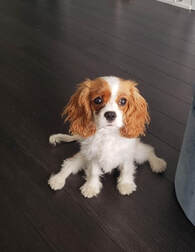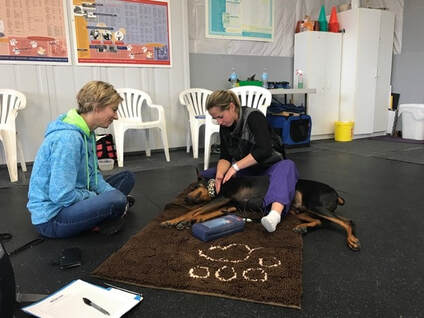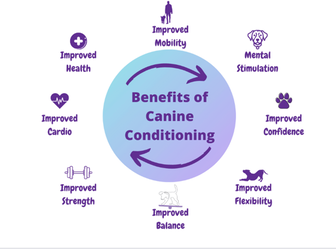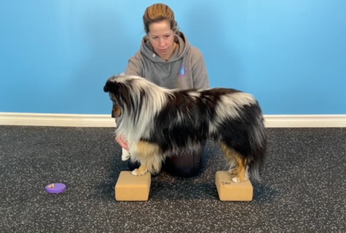|
“Knowledge isn’t power. Applied knowledge is power.” This is a powerful quote by American motivational speaker Eric Thomas, and I couldn’t agree with it more. In last week’s blog, the first of this two-part series, I talked about common, general signs of pain in our dogs and specific pain signs in agility dogs. When we understand our dog’s standard movement patterns, we can start to detect deviations from them. So, now that we know how to recognize these signs in part one (you can read it here), we will dive into what YOU can do as a dog owner to detect these subtle signs of injury SOONER in your agility dog. Let's dive into my top 5 tips:1. YOUR BASELINE IS YOUR GOLDMINE.What do I mean by this? I want you to get a picture of how your dog moves in both daily life and in the sport of agility. It is time to hone your observation skills! The more knowledge we have on our dogs’ natural tendencies and movement patterns, the more likely and quicker you will be able to detect deviations from this! Here are a few life and agility-specific examples:
This may seem simple, but I want you to observe how your dog does the above items. For example, if your dog lies typically down by weight shifting back and going into the sphinx down position but suddenly starts to sit and then lie down – perhaps this is an early indication of some back pain. As we discussed in the first part of this blog – we have to look at the whole picture and not one specific incident – we have to build the case. 2. PUT THOSE SMARTPHONES TO GOOD USE. ALWAYS RECORD ON VIDEO ALL YOUR TRAINING SESSIONS AND COMPETITIONS.Dogs move so quickly, and we can not often detect changes in real-time. It should be standard practice to film and review your sessions that same day. Often times if we leave reviewing until several days later, it doesn’t get done. You could miss out on valuable information about your dog if you leave it up to the naked eye! Quinn typically has beautiful weave poles and completes them using a slalom pattern. In this picture, she avoids reaching with her front left limb and instead crosses with the wrong leg (right) over first. This was the only indication I had that something was off! Sure enough, after completing a full physical exam, I diagnosed her with a bicep strain, and she was out of training and competitions for eight weeks. Had I not filmed this, I would not have known something was wrong! As a typical Aussie and a high-drive working dog, Quinn doesn’t tend to show obvious signs of discomfort. Always document and record what you see and find in your sessions, and look for deviations from their normal movement patterns. One session of wide turns does not necessarily mean your dog has a physical issue. Over time though, patterns always emerge! So be sure to observe, record and compare your findings over time. 3. BE PROACTIVE VS. REACTIVE. HAVE YOUR DOG EXAMINED BY A HEALTH PROFESSIONAL EVERY THREE MONTHS.
Health professionals are here to help you. Trust me when I say that because I am one myself and want to help my clients as much as possible with the knowledge and skillset I’ve acquired. Here are a couple of things health professionals can help you with:
When injuries happen or when your dog is off, it can be very unsettling. Having a health professional in your corner can help calm those anxieties about the unknown and get you back on a clear path with goals. "An injury is not just a process of recovery, it's a process of discovery." Conor McGregor 4. DON’T SKIP ON FITNESS! THERE IS SIMPLY NO SUBSTITUTE FOR CANINE FITNESS TRAININGHikes, and walks will not help detect these subtle signs of pain as arousal and motivation drive their movement again – they aren’t thinking! In the canine gym, we ask dogs to move in a very intentional and targeted fashion which often will bring out a side preference, weakness, or a tight muscle – all things we want to identify early before it turns into something more severe. Canine fitness is one of the BEST strategies to help detect subtle changes in your dog. In summary, starting your dog on a canine conditioning journey as early as possible can help prevent injuries in the long run. On top of preventing injuries, canine conditioning can help your dog with: These are all fantastic benefits, aren’t they? However, there are MANY more that we sometimes don’t consider. Canine conditioning can also help you:
I'll scream this at the top of my lungs until the end of time. First, we MUST warm up and cool down our dogs. It primes their bodies for the upcoming activity, it tells us where they are emotionally (are they focused or distracted), it strengthens our connection with them, and it can tell us if something is wrong with them, for example, are they completing their warm-up turns to the left as tight as to the right? Remember, once arousal kicks in, it will mask any signs of pain! This is a fact because this is how dogs’ brains are wired. I often hear from my clients, “My dog never showed any signs of injury,” when I ask them about their dog’s behaviour during the warm-up stage; oh, surprise! They weren’t doing it. So, do not skip the warm-up stage, please. I’m so passionate about this that I will even consider designing a bumper sticker for my car! So, now that you’ve read my top 5 tips to prevent injuries in your agility dog, I want to show you a quick balance test that you can do right now. Introducing the Single-leg Paw Lift Test The goal of the test is to have the dog standing in a balanced position on two stable pieces of equipment while one limb is lifted for 20 seconds. What does this test assess?
Note: Some dogs are aversive to having their limbs picked up. If this is the case for your dog, work towards getting them accustomed to having each limb handled before completing this test. Steps:
Key Observations:
This test is one of many that can help you determine if your dog has a limb preference, is offloading a particular limb, or is well-balanced. Tests like this help to give you more information so you can be proactive in your approach to their health and performance. You cannot gather this information from hiking or walking your dog. Having an active or athletic dog means digging deep into their preferences and natural movement patterns so you can augment any deviations or imbalances in the canine gym. This test was only a sneak peek into a brand-new and informative evaluation I’ve recently put together. There’s no other test like this in the market right now. Introducing The Fit Dog Home Evaluation (FDHE)!Why do you need this? If you want to know if your dog has any imbalances, side preferences, or preferred movement patterns, you’ll want to get your hands on this. As the name suggests, this evaluation will provide a starting point to create a baseline that you can use over time to measure and track your canine fitness journey. The FDHE will evaluate the following:
If you are interested in taking this evaluation – don’t wait! You are one click away from setting your dog up for success and minimizing their chances of injury. The FDHE is a scoring system based on observable behaviours and movement patterns. At the end of this test, you will have a score and an idea of what you need to work on in the canine gym! Remember, the more information on your dog you can gain, the more you can augment their weaknesses and turn them into strengths!! This assessment tool is not meant to replace an assessment completed by a health professional. Still, it can give you critical information about your dog’s health, preferences, their movement patterns and their ability to complete foundation behaviours in the canine gym! In the sport of agility, quality of movement and maximizing your dog’s ability to use all limbs properly and symmetrically are critical to long-term success and avoiding staying off the sidelines. By understanding your dog’s typical movement patterns and your ability to recognize the subtle signs of pain, you can take a more proactive approach to their care and minimize injury severity and time away from training and competing in the sport of agility. AuthorHi, I’m Carolyn McIntyre, an animal rehabilitation trainer and registered physiotherapist. I am the owner/operator of McIntyre Canine Rehabilitation, located in Erin, Ontario, Canada. I specialize in helping canine athletes reach superior physical performance while minimizing injuries and boosting longevity in their sport.
0 Comments
Leave a Reply. |
AuthorCarolyn McIntyre Archives
June 2024
Categories
All
|






 RSS Feed
RSS Feed